When accurate dispensing of liquids, chemicals or other substances into a process or system is needed, metering pumps are there putting in yeoman’s work. Often taken for granted, metering pumps are utilized in several different industries where their tremendous accuracy and detail can be seen in products used in our everyday lives. This article explores the common types and applications of metering pumps.
What is a Metering Pump?
Metering pumps, also known as dosing pumps, are positive displacement pumps that are designed to deliver specific, small amounts of liquid with calculated flow control. Metering pumps are known for their consistently high level of accuracy and leak-free liquid containment, which in turn make them a great choice for pumping a wide range of chemicals including acids, bases, corrosives, viscous liquids, and slurries. The construction of a metering pump varies, but generally they have a pump head, motor, and either an electronic or manual adjustment mechanism.
Common Types of Metering Pumps
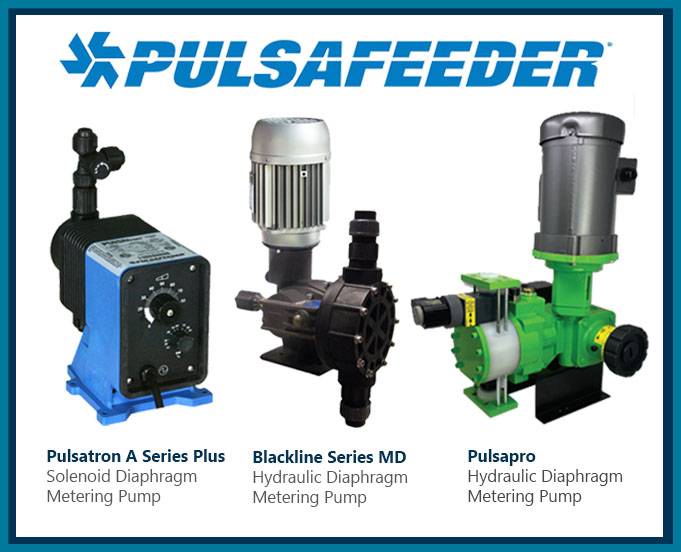
Diaphragm Metering Pumps
Diaphragm metering pumps use a flexible diaphragm that is repeatedly compressed and depressed to move fluid into and out of the pumping chamber. When the diaphragm expands, the suction created draws liquid into the inlet. When the fluid chamber is full, the diaphragm compresses and the fluid is expelled. To confirm flow continues in only one direction diaphragm metering pumps often have inlet and outlet valves. Diaphragm metering pumps can be fitted with variable frequency drives (VFDs) that provide even greater dosing accuracy and reduces the chance of operator error, pumping inaccuracies and chance of leakage. The fact that diaphragm metering pumps are sealless and have several chemical resistant material options available allow them to handle a variety of liquids, including slurries, bases and acids. There are different types of diaphragm metering pumps, including a solenoid diaphragm metering pump and a hydraulic metering diaphragm pump.
A solenoid diaphragm metering pump provides precise chemical dosing and is used in several industries, including wastewater treatment, pharmaceuticals and agriculture. The pump operates by using a solenoid to control the motion of a diaphragm that pumps the chemical solution. The solenoid creates a magnetic field when an electrical current passes through it. The magnetic field moves the diaphragm back and forth and that motion pushes the chemical media through the pump. A solenoid metering pump is typically equipped with several safety features such as a pressure relief valve and leak detection system to prevent over-pressurization and chemical spills.
A hydraulic diaphragm metering pump is a type of positive displacement pump that uses a flexible diaphragm that is actuated by a hydraulic system to pump fluids. A piston or plunger is used to create pressure on one side of the diaphragm, causing the diaphragm to flex, creating vacuum on the opposite side of the diaphragm. This draws the liquid into the pump’s inlet and when the diaphragm flexes back to its original position the fluid is pushed out through the outlet valve. Like other metering pumps, hydraulic diaphragm metering pumps provide accurate dosing of liquids even at low flow rates. Hydraulic metering diaphragm pumps can be constructed out of several different chemical resistant plastics and elastomers to be compatible with a wide range of chemicals and fluids. They are commonly utilized for several applications, including in the chemical processing, water treatment and food and beverage industries.
Piston Metering Pumps
A piston metering pump is a type of positive displacement pump that uses a piston to displace fluid in the reservoir chamber. The pump’s flow rate and dispense amount is determined by the stroke rate and internal volume of fluid in the pumping chamber. Piston pumps work with the piston or plunger moving downward, which opens the inlet valve and creates suction allowing liquid to enter. The piston then moves upward c
losing the inlet valve. The inlet valve being closed pressuriz
es the liquid and discharges the liquid out of the cylinder. Piston pumps are capable of handling liquids of varying viscosities, temperatures and pressures making them versatile for a wide variety of applications.
Common applications piston metering pumps are used in are in chemical processing, oil and gas and water treatment.
Peristaltic Metering Pumps
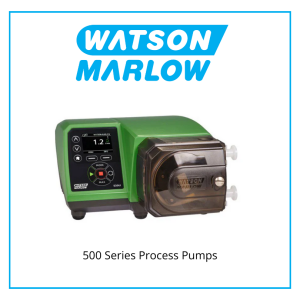
A peristaltic pump is a type of positive displacement pump that transports liquids without encountering the component parts. From intake to discharge, the liquid only encounters the tubing. Peristaltic pumps transport liquids through flexible tubing that is squeezed by a series of rollers, also called shoes, on a rotating wheel.
The first roller compresses the tubing, which creates vacuum that pulls the liquid into the pump. A second roller rolls over the hose that pushes the liquid toward the pump outlet. The cycle keeps repeating as the rollers rotate. The shoe position at the discharge side prevents any backflow from occurring. Peristaltic pumps excel at pumping viscous fluids and particulate matter and have check valves to prevent backflow.
Internal Gear Pumps
An internal gear pump is a type of positive displacement pump that uses two rotating interlocking gears to displace fluid. Output is directly proportional to gear rotational speed with internal gear pumps, which make them ideal for metering and blending applications. Rugged construction and solid, spur shaped gears allow internal gear pumps to excel at pumping high viscosity fluids. Internal gear pumps work with liquid entering the suction port between a rotor gear and idler gear during the suction phase. The liquid is sealed in the cavities created by the meshing gear teeth and rotates against the pump casing and partition. The seal created by the gear teeth at the discharge side of the pump reduces the fluid volume and the fluid is discharged under pressure. Common types of applications for internal gear pumps include resins and polymers, adhesives, edible fats and oils and asphalt emulsion.
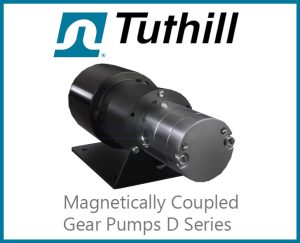
External Gear Pumps
Like internal gear pumps, external gear pumps use a set of meshing gears to transfer fluid from the inlet to the outlet of the pump. The external gear pump consists of two gears, the drive gear and the driven gear, which operate in opposite directions. The fluid is drawn into the inlet and trapped between the gears and the pump housing. As the gears rotate, fluid is pushed along the housing until it’s eventually discharged at the outlet port. External gear pumps have precise control over the volume of fluid that is pumped per revolution of the gears. Volume is controlled by adjusting the positions of the gears relative to each other and by controlling the speed of rotation. Applications external gear pumps are commonly used for include transferring chemicals for mixing, blending, and dosing applications. They are also used for several other industrial applications, such as circulating lubricating oils and in fuel injection systems. Transferring pharmaceuticals and food and beverage products are common hygienic applications of external gear pumps.
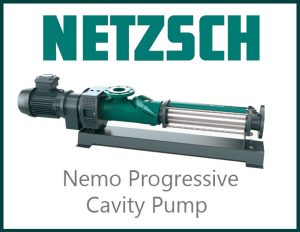
Progressive Cavity Pumps
Progressive cavity pumps are positive displacement pumps that accurately and consistently meter precise amounts of liquids and semi-solid materials. They are also known for their low-pulsation and gentle delivery of a wide variety of substances, including adhesives, petroleum and food products. Progressive cavity pumps operate by using a helical rotor that rotates inside a stator. As the rotor turns, it creates a sealed chamber that moves fluid through the pump. The flow rate is determined by the size of the chamber, the speed of the rotor and the number of revolutions the rotor makes per minute. The general design of the progressive cavity metering pump makes it ideal for handling a wide range of viscosities and solids content that would likely damage other types of pumps. Top progressive cavity pump manufactures, like Roto Pumps and Netzsch, offer some of the most robust, accurate and gentle delivering progressive cavity pumps in the marketplace.
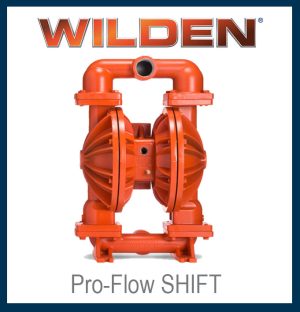
Air-Operated Double Diaphragm (AODD) Pumps
An Air-Operated Double Diaphragm (AODD) pump is a type of positive displacement pump that uses compressed air to power metering and dosing applications. It works by using compressed air to move two flexible diaphragms back and forth, which alternately draw in and eject fluid through the pumps. An AODD metering pump delivers accurate and reliable small volumes of fluid at a consistent rate. Constructed in a variety of materials to be chemically resistant to different applications, AODD pumps can handle a broad range of fluids including abrasive, corrosive and viscous fluids.
Common Applications of Metering Pumps
Chemical Manufacturing
Chemical catalysts are additives needed to keep chemicals in manufacturing plants from losing their effectiveness. Chemical metering pumps inject these catalysts with precision at the proper pressures and temperatures to aid in chemical preservation. Also, creating disinfecting products such as bleach for industrial and household use would also not be possible without the aid of metering pumps providing the accurate amount of ingredients and additives for a safe product.
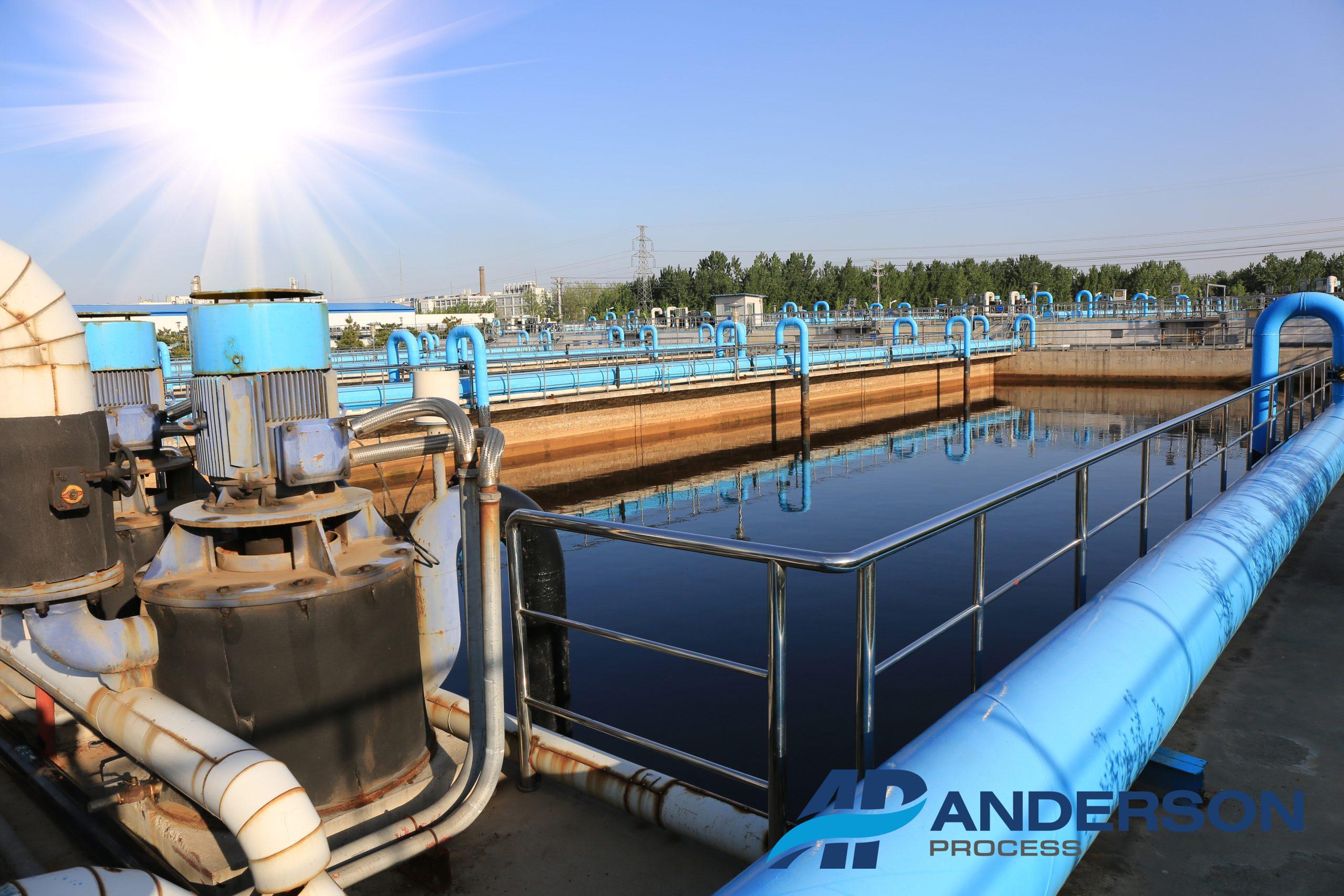
Water Treatment
Metering pumps are used for dosing chemicals in water treatment applications. Water treatments, such as disinfection, PH adjustment and metering of polymers for coagulation are commonly performed by metering pumps. Metering pumps dose chemicals like chlorine to kill pathogens or help the water maintain the proper PH level. Without metering pumps for water treatment, the health risks associated with untreated drinking water would be devastating.
Food & Beverage
Used for the accurate dosing of ingredients such as flavors, colorants and preservatives, the food industry would not resemble what it has come to be without metering pumps. Most food products would be less appetizing taste wise and aesthetically less attractive without the help of metering pumps. Metering pumps also provide accurate dosing of vitamins and food additives that make food more nutritious and safer to eat.
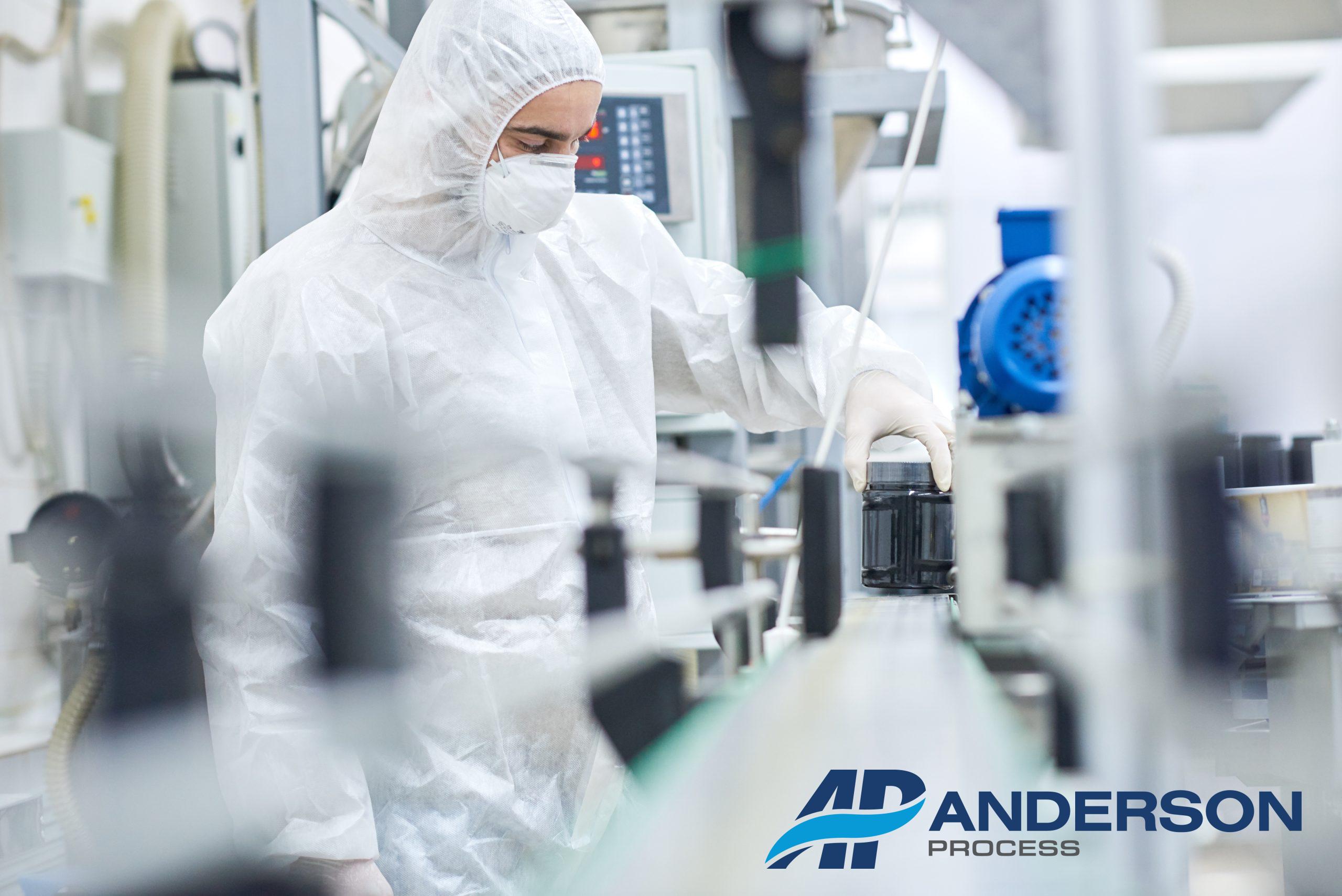
Pharmaceuticals
Metering pumps are regularly used for precise dosing of ingredients in pharmaceutical manufacturing processes. The production of intravenous drugs and other medical treatments, as we know them today, would not be properly balanced and have potential serious safety consequences without the aid of metering pumps. Sterilizing agents that allow hospitals to be sanitary, hygienic spaces also would not be able to be created without metering pumps.
Agriculture
Metering pumps are essential to a farm’s crop quality. They dispense water, fertilizers and pesticides which ensure the best possible plant growth and crop yield, while supporting soil PH. The quality of our produce would be massively affected if metering pumps weren’t used to deliver exactly what crops need, when they need it. Our food supply would also be negatively affected. Greenhouses and hydroponics growing facilities also use metering pumps to precisely inject or dose fluids (water, fertilizer, etc.) on a system’s flowrate.

Oil & Gas
Metering pumps are responsible for precise injection of chemicals like corrosion inhibitors, scale inhibitors and biocides into oil and gas wells to prevent issues such as corrosion and fouling. The efficiency and quality of oil and gas would be subpar and potentially not be usable at all (in some cases) without metering pumps precisely adding in the necessary additives. Metering pumps can be used in all phases of oil production including production, processing, refining, transmission and distribution.
Printing
Metering pumps are paramount to printing applications and are used in printing inks, coatings and adhesives to ensure consistent and precise application. They ensure the right amount of ink is applied to the surface for consistent print quality and are capable of mixing colors for accurate color reproduction. The glossy or protective coatings on paper products are applied by metering pumps. They can also be used to add adhesives to labels, tapes and other adhesive backed products to printing surfaces.
Anderson Process is distributor for several top manufacturers of metering pumps, including Pulsafeeder, Neptune, Hydra-Cell, Tuthill and Wilden. Find the right metering pump for your application today!

A peristaltic pump is a type of positive displacement pump that transports liquids without encountering the component parts. From intake to discharge, the liquid only encounters the tubing. Peristaltic pumps transport liquids through flexible tubing that is squeezed by a series of rollers, also called shoes, on a rotating wheel.
The first roller compresses the tubing, which creates vacuum that pulls the liquid into the pump. A second roller rolls over the hose that pushes the liquid toward the pump outlet. The cycle keeps repeating as the rollers rotate. The shoe position at the discharge side prevents any backflow from occurring. Peristaltic pumps excel at pumping viscous fluids and particulate matter and have check valves to prevent backflow.
Internal Gear Pumps
An internal gear pump is a type of positive displacement pump that uses two rotating interlocking gears to displace fluid. Output is directly proportional to gear rotational speed with internal gear pumps, which make them ideal for metering and blending applications. Rugged construction and solid, spur shaped gears allow internal gear pumps to excel at pumping high viscosity fluids. Internal gear pumps work with liquid entering the suction port between a rotor gear and idler gear during the suction phase. The liquid is sealed in the cavities created by the meshing gear teeth and rotates against the pump casing and partition. The seal created by the gear teeth at the discharge side of the pump reduces the fluid volume and the fluid is discharged under pressure. Common types of applications for internal gear pumps include resins and polymers, adhesives, edible fats and oils and asphalt emulsion.

External Gear Pumps
Like internal gear pumps, external gear pumps use a set of meshing gears to transfer fluid from the inlet to the outlet of the pump. The external gear pump consists of two gears, the drive gear and the driven gear, which operate in opposite directions. The fluid is drawn into the inlet and trapped between the gears and the pump housing. As the gears rotate, fluid is pushed along the housing until it’s eventually discharged at the outlet port. External gear pumps have precise control over the volume of fluid that is pumped per revolution of the gears. Volume is controlled by adjusting the positions of the gears relative to each other and by controlling the speed of rotation. Applications external gear pumps are commonly used for include transferring chemicals for mixing, blending, and dosing applications. They are also used for several other industrial applications, such as circulating lubricating oils and in fuel injection systems. Transferring pharmaceuticals and food and beverage products are common hygienic applications of external gear pumps.

Progressive Cavity Pumps
Progressive cavity pumps are positive displacement pumps that accurately and consistently meter precise amounts of liquids and semi-solid materials. They are also known for their low-pulsation and gentle delivery of a wide variety of substances, including adhesives, petroleum and food products. Progressive cavity pumps operate by using a helical rotor that rotates inside a stator. As the rotor turns, it creates a sealed chamber that moves fluid through the pump. The flow rate is determined by the size of the chamber, the speed of the rotor and the number of revolutions the rotor makes per minute. The general design of the progressive cavity metering pump makes it ideal for handling a wide range of viscosities and solids content that would likely damage other types of pumps. Top progressive cavity pump manufactures, like Roto Pumps and Netzsch, offer some of the most robust, accurate and gentle delivering progressive cavity pumps in the marketplace.

Air-Operated Double Diaphragm (AODD) Pumps
An Air-Operated Double Diaphragm (AODD) pump is a type of positive displacement pump that uses compressed air to power metering and dosing applications. It works by using compressed air to move two flexible diaphragms back and forth, which alternately draw in and eject fluid through the pumps. An AODD metering pump delivers accurate and reliable small volumes of fluid at a consistent rate. Constructed in a variety of materials to be chemically resistant to different applications, AODD pumps can handle a broad range of fluids including abrasive, corrosive and viscous fluids.
Common Applications of Metering Pumps
Chemical Manufacturing
Chemical catalysts are additives needed to keep chemicals in manufacturing plants from losing their effectiveness. Chemical metering pumps inject these catalysts with precision at the proper pressures and temperatures to aid in chemical preservation. Also, creating disinfecting products such as bleach for industrial and household use would also not be possible without the aid of metering pumps providing the accurate amount of ingredients and additives for a safe product.

Water Treatment
Metering pumps are used for dosing chemicals in water treatment applications. Water treatments, such as disinfection, PH adjustment and metering of polymers for coagulation are commonly performed by metering pumps. Metering pumps dose chemicals like chlorine to kill pathogens or help the water maintain the proper PH level. Without metering pumps for water treatment, the health risks associated with untreated drinking water would be devastating.
Food & Beverage
Used for the accurate dosing of ingredients such as flavors, colorants and preservatives, the food industry would not resemble what it has come to be without metering pumps. Most food products would be less appetizing taste wise and aesthetically less attractive without the help of metering pumps. Metering pumps also provide accurate dosing of vitamins and food additives that make food more nutritious and safer to eat.

Pharmaceuticals
Metering pumps are regularly used for precise dosing of ingredients in pharmaceutical manufacturing processes. The production of intravenous drugs and other medical treatments, as we know them today, would not be properly balanced and have potential serious safety consequences without the aid of metering pumps. Sterilizing agents that allow hospitals to be sanitary, hygienic spaces also would not be able to be created without metering pumps.
Agriculture
Metering pumps are essential to a farm’s crop quality. They dispense water, fertilizers and pesticides which ensure the best possible plant growth and crop yield, while supporting soil PH. The quality of our produce would be massively affected if metering pumps weren’t used to deliver exactly what crops need, when they need it. Our food supply would also be negatively affected. Greenhouses and hydroponics growing facilities also use metering pumps to precisely inject or dose fluids (water, fertilizer, etc.) on a system’s flowrate.

Oil & Gas
Metering pumps are responsible for precise injection of chemicals like corrosion inhibitors, scale inhibitors and biocides into oil and gas wells to prevent issues such as corrosion and fouling. The efficiency and quality of oil and gas would be subpar and potentially not be usable at all (in some cases) without metering pumps precisely adding in the necessary additives. Metering pumps can be used in all phases of oil production including production, processing, refining, transmission and distribution.
Printing
Metering pumps are paramount to printing applications and are used in printing inks, coatings and adhesives to ensure consistent and precise application. They ensure the right amount of ink is applied to the surface for consistent print quality and are capable of mixing colors for accurate color reproduction. The glossy or protective coatings on paper products are applied by metering pumps. They can also be used to add adhesives to labels, tapes and other adhesive backed products to printing surfaces.
Anderson Process is distributor for several top manufacturers of metering pumps, including Pulsafeeder, Neptune, Hydra-Cell, Tuthill and Wilden. Find the right metering pump for your application today!
